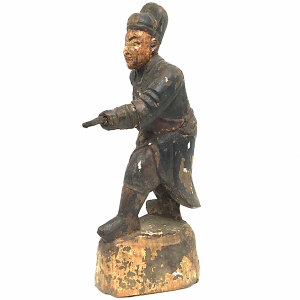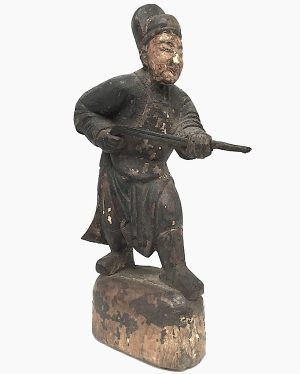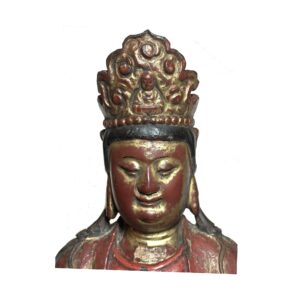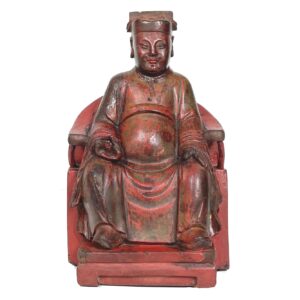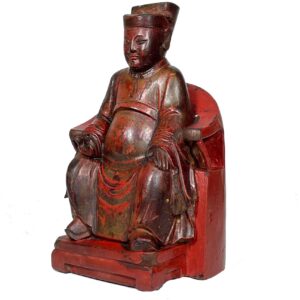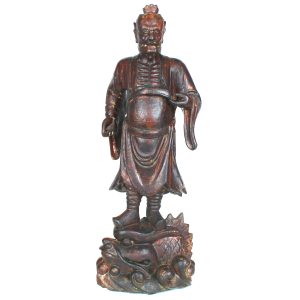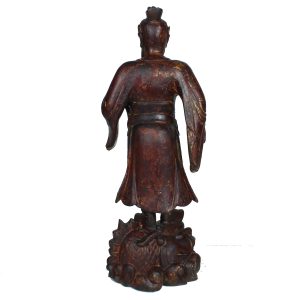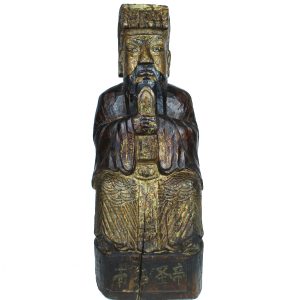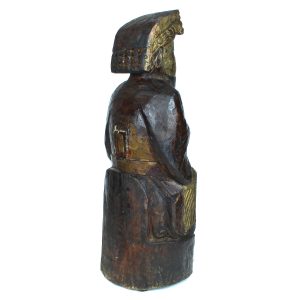Showing 61–72 of 102 results
-
Sale!


$315.00 Original price was: $315.00.$275.00Current price is: $275.00.
H: 9 ” W: 3.625″ D: 3.5 ” | FREE SHIPPING WITHIN CONTINENTAL U.S.!
This ancestor figure of a huntsman in the round is unique, standing on a domed pedestal, facing half right holding a flint lock, wearing a hunting coat, a two-level hat, traditional under- and outer-garment, and thick boots. As the noted scholar on Chinese wood carvings stated, a similar figure like this “unusual and extraordinary ancestral image of a huntsman with a flintlock gun, was the only ancestral image in his vast collection which “depicts the calling of the deceased.”
-


$7,300.00
H: 28.25 W: 12.75” D: 9.75” | CALL 213-568-3030 OR EMAIL [email protected] FOR SHIPPING COST
Although they are Buddhist images, Lohans are portrayed as a real person with very individual, distinctive, and un-idealized features. His benevolent youthful sweetly smiling face with downcast eyes is an image of compassion, wisdom and peace.This exceptional, beautifully crafted rare 17-18th century Ming/Qing large Lohan is from the same Buddhist location as the foreign-born heavy bearded Lohan Bodhidharma, and the same artist may have carved both. We recommend keeping them as a pair to display together.
-
Sale!


$5,900.00 Original price was: $5,900.00.$3,900.00Current price is: $3,900.00.
H: 34″ W: 12″ D: 15″ | CALL 213-568-3030 OR EMAIL [email protected] FOR SHIPPING.
This rare and intriguing Nanhai Guanyin sits in her cave with internal layers at Putuo. On the top is the donor who commissioned the piece, seldomly placed within the Guanyin tableau.Two levels of attendant pairs flank her: the upper with her two acolytes Longnu, (the Dragon Princess) on her right holding a flaming gem, and Shan Tsai (Sudhana) on her left with hands, now missing, clasped in anjali mudra of reverence and two generic attendants are on the on the bottom. This work is truly remarkable in its execution and iconography.
-
Sale!


$3,995.00 Original price was: $3,995.00.$2,900.00Current price is: $2,900.00.
H: 19″ W: 10″ D: 8″ | CALL 213-568-3030 OR EMAIL [email protected] for shipping INFORMATION.
This wonderfully carved Nanhai Guanyin statue is notable for its highly ornate and beautiful diadem centered by an elaborately framed image of Buddha Amitabha seated in meditation. Her vibrant aura radiates spirituality and opulence, serenity and strength, as well as compassion and grace, making this statue a truly masterful piece of art.
-
Sale!


$650.00 Original price was: $650.00.$325.00Current price is: $325.00.
H: 7.25” W: 4.625” D: 3.5” | FREE SHIPPING WITHIN CONTINENTAL U.S.!
This finely carved ancestor wears official’s attire and hat and sits in a horseshoe chair with his feet on a pedestal to emphasize his power and status, although he appears to be a lovwer level civilian official. It is masterfully carved and lacquered and is painted on front and back in red with traces of gilt – all propitious colors of “fu” as a wish for wealth, health, good fortune, long life and long life – that has faded over it years of use into a great patina.
-
Sale!


$4,600.00 Original price was: $4,600.00.$3,900.00Current price is: $3,900.00.
H: 30.5″ W: 19.25″ D: 11.75 | CALL 213-568-3030 OR EMAIL [email protected] FOR SHIPPING
This fine and rare kneeling image is Shen Nong one of most revered cultural heroes in Chinese mythology. He is the Founder of Natural Medicine, the Father of Agriculture and an Earth God. He is said to have invented farming implements and introduced planting, cultivation, crop rotation and methods of raising domestic animals and the author of the earliest known Chinese medical classic covering medical physiology, anatomy and acupuncture – the Canon of Internal Medicine. It is a perfectly fitting and unique carving for a professional in the health care, pharmaceutical agricultural professions.
-


$795.00
Initially linked to the Big Dipper in Chinese mythology, Wen Chang is worshipped in the 3rd and 8th months as the God of several spheres: Literature, Books and Writing, Education, Learning and Examinations and is the patron saint of scholars. As one of the revered Taoist-deities, hero and one of the house-gods closely associated with…
-


$295.00
Taoist images were represented as scholars, sages, heroes, deities, officials and priests. When these images are taken out of context they are very difficult to identify so we describe them in generic terms as a Taoist Officials, Priests or Deities. We identify this image an Official since he holds a hu-tablet associated with officials and…
-


$240.00
Taoist images were represented as scholars, sages, heroes, deities, officials and priests. When these images are taken out of context they are difficult to identify so we describe them in generic terms. Seated on a backless chair wearing long flowing officials-robes with deep folds, we use the terms officials/priests for this image, since he his…
-
Sale!


$450.00 Original price was: $450.00.$395.00Current price is: $395.00.
Ht: 9″ W: 5″ D: 3.5″ | FREE SHIPPING WITHIN CONTINENTAL U.S.!
During the Ming and Qing dynasties small images of Taoist officials and priests were often shown holding a cup of the elixir of life to place on home altars along with ancestor figures, house gods and other religious images to bring blessings (fu) to the household. By commissioning figures like this artful carving, families honored their ancestors and met their filial piety duties. Mounted on an acrylic stand.
-


$395.00
When ancestral images are taken out of context they are very difficult to identify so we describe them in generic terms as a Chinese Officials or Taoist Officials. This antique-Chinese-wood-carving may represent the noted historical figure the principal regent Dorgon of the first Qing Emperor Shunzhi who ruled from 1643-1650 as a”quasi” emperor based on…
-


$795.00
This fine antique Chinese wood carving was likely placed in a clan shrine or home altar with other religious images, ancestor figures or folk heroes reflecting the Chinese syncretic tradition that adhered to multiple spiritual and belief systems. Although it is difficult to identify specific figures, this image is likely a Taoist priest in officials…
End of content
End of content

